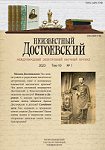Население Дарового по ревизским сказкам 1830-1850-х гг.
The Population of Darovoe Based on Revision Tales of the 1830s-1850s
Author(s): Tatyana Nikolaevna DementyevaSubject(s): Museology & Heritage Studies, Russian Literature, Family and social welfare, 19th Century
Published by: Петрозаводский государственный университет
Keywords: Darovoe; confessional statements; revision tales; M. F. Dostoevskaya; M. M. Dostoevsky; F. M. Dostoevsky; V. M. Ivanova (nee Dostoevskaya); serfs; courtyards; family;
Summary/Abstract: Interaction with the serfs of the Darovoe estate, which belonged to the parents of F. M. Dostoevsky in the first half of the 19th century, made a strong impression on the future writer. Some peasants were close to the Dostoevsky family, they were mentioned in family correspondence and even became prototypes of the characters in the works of the writer and his older brother Mikhail. Dostoevsky met again with his childhood acquaintances from the village during his last visit to Darovoe in the summer of 1877. Until now, the only sources that gives an idea of the inhabitants of Darovoe were church records: metric books and confessional statements. In 1939, V. S. Nechaeva published the “List of peasants of the village of Darovoe and the village of Cheremoshnya according to the 1835 church bulletin.” Another source for studying the demography of Darovoe and Cheremoshnya is the revision tales. In this article are analyzed the data of the 8th — 10th revisions on Darovoe for the first time, the transcript of the 8th revision published in the appendix to it. These documents made it possible to trace the changes in the composition of the inhabitants of Darovoe from 1834 to 1858 and became an addition to the church bulletin of 1835. Three audits took place during this period, revealing the practical absence of changes in the composition of the inhabitants of Darovoe: there were 11 peasant families (the exception was in 1850, when there were ten families). Such isolation of the Darovoe community contributed to the preservation of local traditions and customs, which F. M. Dostoevsky could observe while living in Darovoe. Many descendants of the Dostoevsky peasants still live in Darovoe today, and the genealogy of the peasants of the village of Darovoe can be traced up to our days.
Journal: Неизвестный Достоевский
- Issue Year: 10/2023
- Issue No: 1
- Page Range: 106-144
- Page Count: 39
- Language: Russian

